It’s not about nitpicking word count; it comes down to holding the reader’s attention long enough to stick out in the never-ending sea of emails.
One analysis of over 20 million cold emails found that the more people you email, the lower the open rates go. That statistic might as well say, “the harder you work, the worse the results get.” But in reality, being successful in sales isn’t about doing more — it’s about being more effective. This makes learning how to write a sales email that people want to respond to more important than ever.
Let’s look at how email length can help you get the results you want from your email marketing strategy.
Table of Contents
Ideal Email Length
For almost a decade, it’s been said that the ideal email length is 50 to 125 words. The origin of this famous numeral is a 2016 Boomerang study, which analyzed 40 million emails. Despite its age, that Boomerang study is still used as a benchmark thanks to the depth of research. They found the following correlations between email word count and response rates:
- 200 words = 48% response
- 175 = 49% response
- 150 = 49% response
- 125 = 50% response
- 100 = 51% response
- 75 = 51% response
- 50 = 50% response
- 25 = 44% response
- 10 = 36% response
Boomerang also reviewed email sentiment and found that messages that expressed either moderate positivity or negativity evoked 10 to 15% more responses than completely neutral emails.
But, sales reps should know, the research discovered too much emotion in messages resulted in similar response rates as neutral emails. “Flattery works, but excessive flattery doesn’t,” Alex Moore wrote in the report.
What’s changed since this study’s birth? Well, email still has incredible ROI. New tools, like our AI Email Writer, help you write emails faster and more efficiently. But everyone is getting more emails than ever before, like a boat taking on more and more water.
Research by Constant Contact reinforces points of Boomerang’s data, which you’ll see below. Some more insightful 2024 data from Constant Contact: 40% of business owners surveyed in the Current State of SMB Marketing report said that they put off managing email campaigns because of a lack of time.
More than half of the surveyed marketers said that they spent less than one hour per day on marketing emails, despite it being (on average) their second most-frequented marketing channel.
The truth is, word count is not the end-all when it comes to writing successful sales emails. These best practices, however, make a huge difference.
Email Length Best Practices
A conversation about word count alone is only skin character-deep. Instead of sweating over an extra sentence or two, let these best practices steer the length of your sales emails.
Don’t go over the maximum email length.
Boomerang’s data is supported by other research, like this study from Constant Contact. In a study of over 2.1 million customers, they found emails with approximately 20 lines of text had the highest click-through rates:
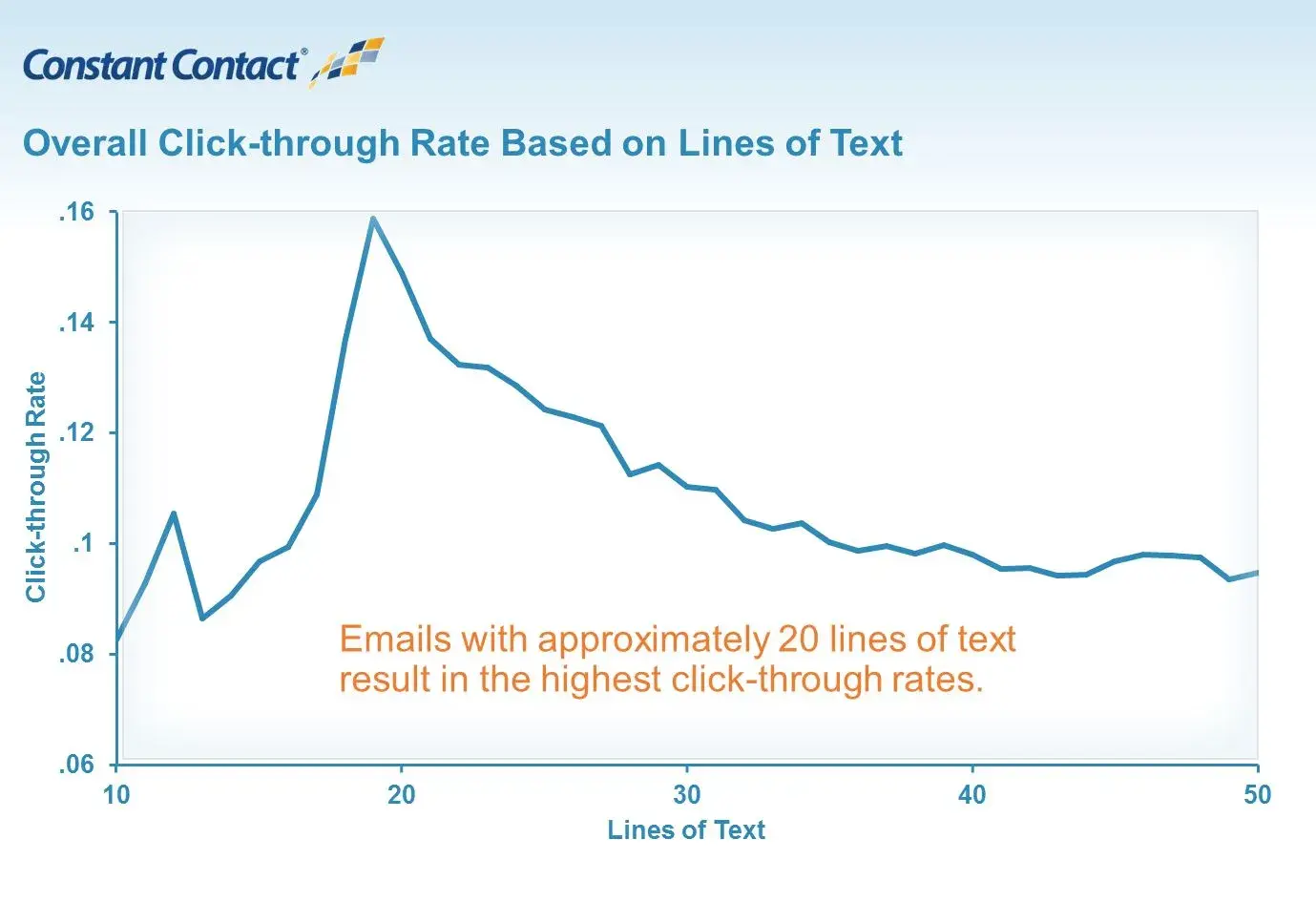
This translates to about 200 words, which is higher than Boomerang’s data, but still provides a helpful range. When in doubt, shorter is generally better, so always err on the side of “less is more,” and keep your emails below 200 words.
Here’s an example of an ultra-brief two-line email template from Sam Wright, head of operations and partnerships at Huntr:
The subject line: [Company] <> Huntr
Email body: We helped [x, y, z, competitor] do Y, which led to Z results. I believe we can be helpful to you as well.
Sam shared this screenshot of the email open and reply rates:

Avoid making your emails too short.
Yes, short and direct emails resonated best with prospects and earned a response. (That’s why former HubSpot account executive Dan Muscatello writes short prospecting emails — two sentences long at most.)
However, Boomerang’s numbers revealed a fine line: Emails that were 10 words or shorter got a response just 36% of the time. You don’t want your emails to feel like you’re just sending a text, or that you forgot the other half of the email before hitting send (been there).
Use visuals to break it up.
Amanda DeLuke is an email expert who has overseen the sending of tens of millions of bulk marketing emails. She echoed the importance of keeping emails brief, and also added this advice:
“Provide a small visual representation (image, icon, etc.) to support each topic/text and provide links out to external content for more details — this will save you a lot of space.”
Don’t be heavy-handed with images.
There’s a lot to say about how images can increase user engagement, but there’s a fine line between attention-grabbing and attention-hogging. HubSpot research suggests that as the number of images in an email increases, your click-through rate will decrease.
Constant Contact also found that imagery impacted click-through rate, with clicks dropping as images are added to an email.

Plan for mobile devices.
Does using the term “mobile devices” make me sound old? Folks are checking their electronic mail everywhere these days: desktops, laptops, phones, tablets, and even smart watches (though getting an email on my wrist is an actual waking nightmare for me, personally).
Statistic: 64% of people primarily check their inbox on mobile devices.
Smaller screens make the case for shorter messages, but there’s also a hidden catch. When people use their mobile to check their inbox, it means that they’re checking their email while multitasking. All the more reason to be brief, using bolded text and bullet points to help with scannability.
Make your message viewable at a glance on mobile. Your point should be clear with one look, without making readers scroll. Test this before sending. Large headers take up valuable space on mobile, so use them with care.
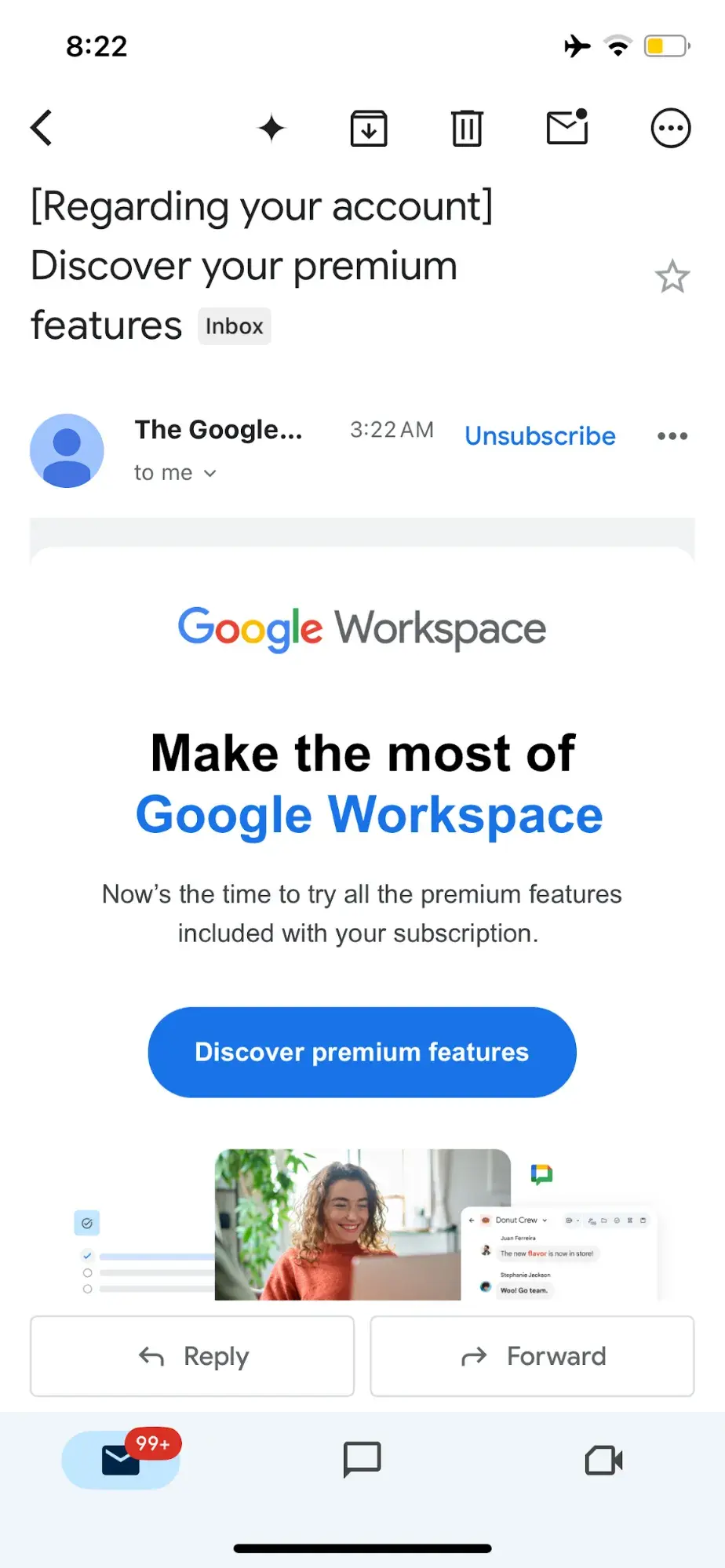
Head back to the third grade.
Why delay the transmission of one’s message with a tedious turn of phrase?
Translation: Why make people’s brains work harder by using fancy language? Writing at a third-grade reading level is a golden rule in all marketing, and email is no exception.
Boomerang’s study found that third-grade level emails performed 36% better in terms of open rate than those written at a college reading level and boasted a 17% higher response rate than emails composed at a high school reading level. Free-flowing, informal emails are best for eliciting a response from recipients.
I’ll show you a tool that can help you measure this below.
Include clear CTAs and ask 1-3 questions.
What is someone supposed to do after they read your email? The call-to-action (CTA) should be clear in every single message you send.
It’s best practice to also include an “ask” in every sales email you send, and reps often ask prospects for information in their messages. But how many questions are too many in an email?
We recommend asking one to three questions in your email. There’s even a built-in safeguard against over-probing prospects (invasive) in the HubSpot email tool:

Shorten email subject lines.
If no one opens your emails, it doesn’t matter how long they are, does it? That’s a rather depressing realization, but it can inspire all of us to spend a little more time on this easily overlooked step.
Statistics: Subject lines with seven words have been found to have the highest open rate at 46.2% (Regie.ai).
The golden rule? Keep it short, to the point, and personalize it. Personalization is so important that it deserves its own call-out.
Do your research and personalize.
If you don’t put in the time to research your prospect and craft a valuable email, it doesn’t matter if you achieve the perfect email length. Your prospect won’t be interested in what you have to say because you haven’t taken the time to say something that matters to them.
One easy trick: Use your recipient’s first name in subject lines. One study found that subject lines mentioning someone’s first name were discovered to have a 29% higher open rate.
Our email tool has dozens of personalization options for the subject line, plus easy A/B testing to drive conversions:
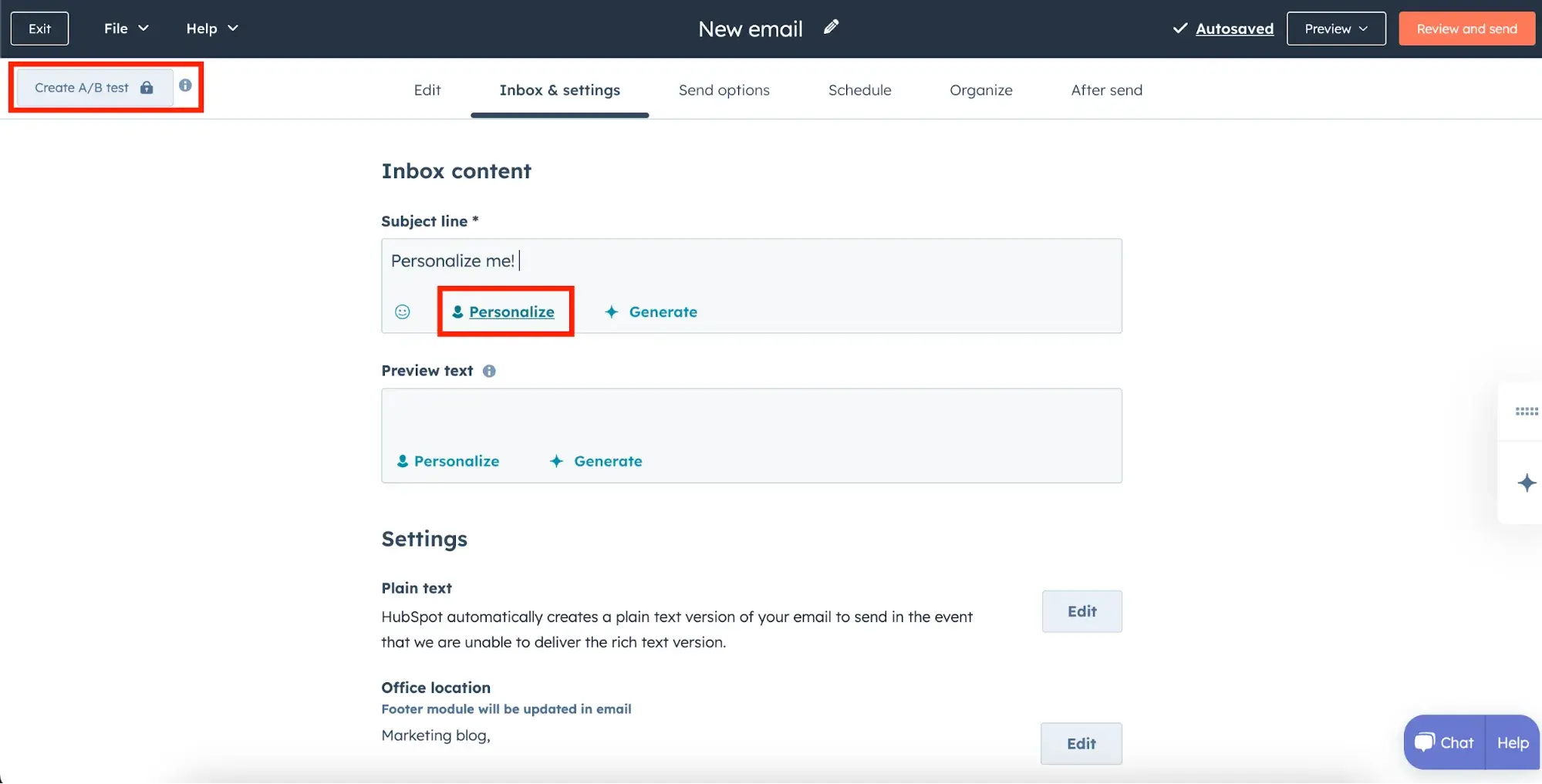
Tips for Ensuring Ideal Email Length
If shorter emails with simple language and clear asks are better, how do you ensure your emails are measuring up? Here are a few tips.
1. Use the free Hemingway App.
Copy and paste your email message into this app and see what grade the readability tracks to, which phrases have simpler alternatives, and how many “hard to read” and “very hard to read” sentences your message contains.
2. Always add a close.
Sales expert Jeff Hoffman advocates that every conversation or email you exchange with a prospect should include a close. Whether you’re asking for more time, contact information, or their business, always make sure you’re asking for something. This makes it as easy as possible for recipients to respond.
Before writing your email, consider what your goal is for this communication and tailor your close accordingly. For example, if I want an email to yield a discovery call, I’ll include that ask at the end, and build the rest of the email around it to support and encourage that close.
3. Don’t waste important real estate.
Your email opening line and greeting are incredibly important, so don’t waste them on “Hi, my name is.” Instead, try, “How can I make your life easier?” or “I noticed your company recently …”.
Similarly, make your email closing lines powerful and intriguing with statements like, “I love ramen as well. Have you tried [restaurant name]?” or “Did the ebook you downloaded change the way you think about [topic]?”
4. Remove excess language.
We tend to add extra words to our writing to soften our message (especially when we’re asking for something or providing constructive feedback). Before sending your email, review for unnecessary language.
For example, here’s a sentence before and after removing filler words:
- Before: “I think it might be a good idea for us to come up with a few ideas that will help us present several scenarios to your executive team when we meet.”
- After: “Let’s brainstorm several scenarios to present to your executive team next week.”
Let’s look at some great examples that embody these best practices (and, bonus: are editable for you to use yourself).
5. Create team email templates.
If you’re working on a sales team, I think it’s important to be consistent with language, CTAs, and offers. Using a template builder tool can ensure consistent messaging and provide a jumping-off point for individual reps in their outreach.
Great Sales Email Examples
The email examples below are all templates included in HubSpot’s email template library. This is a free part of our Marketing Hub! Set up only takes a few minutes, and you can use our software to send out professional sales emails through your work email address.
When you input a contact’s details (like first name and company name), your emails will automatically be customized. This means that you’ll never input the wrong company or misspell a name (even my first name gets butchered).
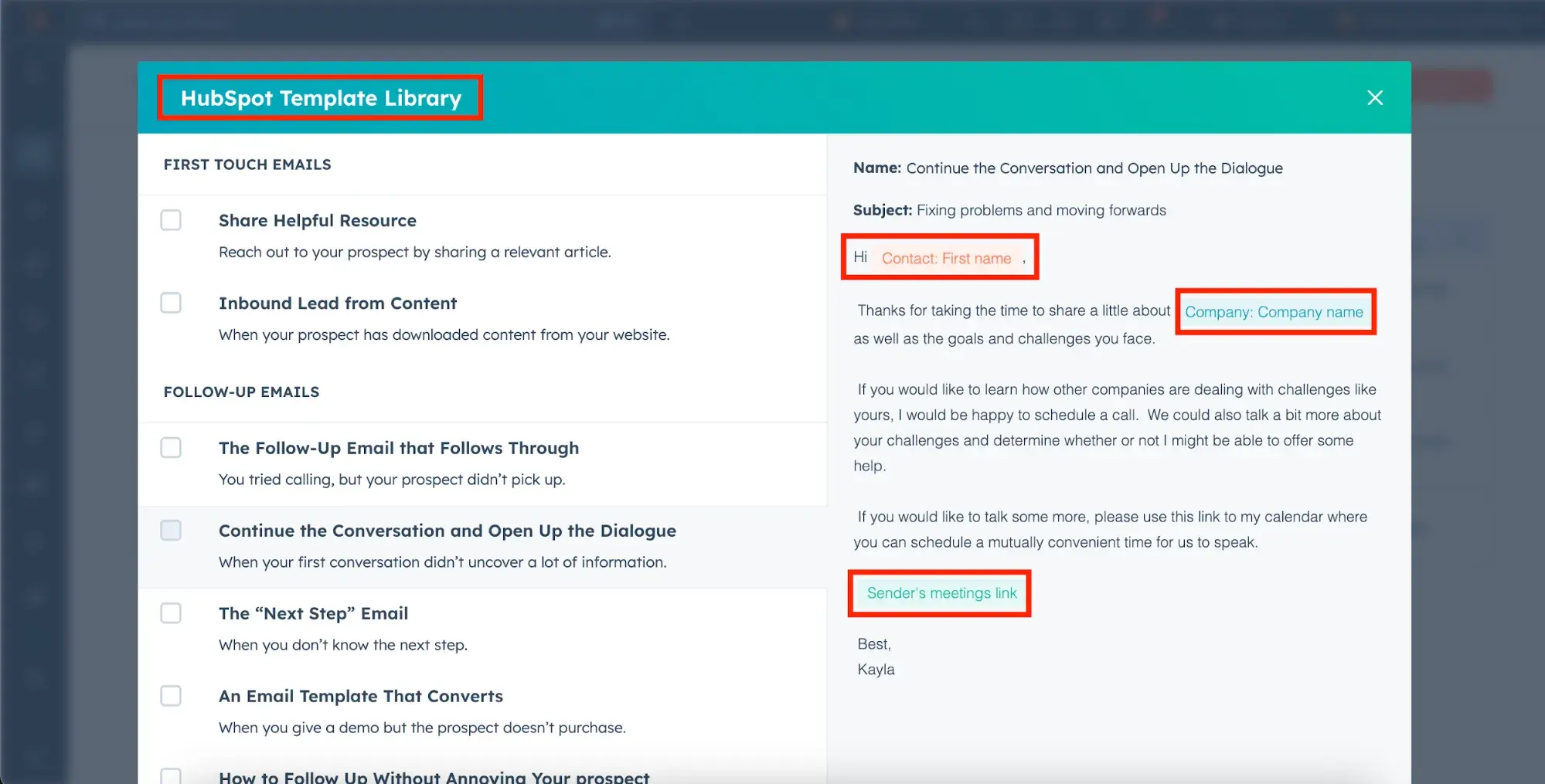
1. The Simple Next Steps Email
I’m ordering these email examples by length: shortest to longest. First up is the “What would need to change?” email. At only 36 words long, this email gets right to the point by asking a prospect what would need to change in order for them to want to discuss working together. It’s a short, cold email that doesn’t waste anyone’s time beating around the bush.
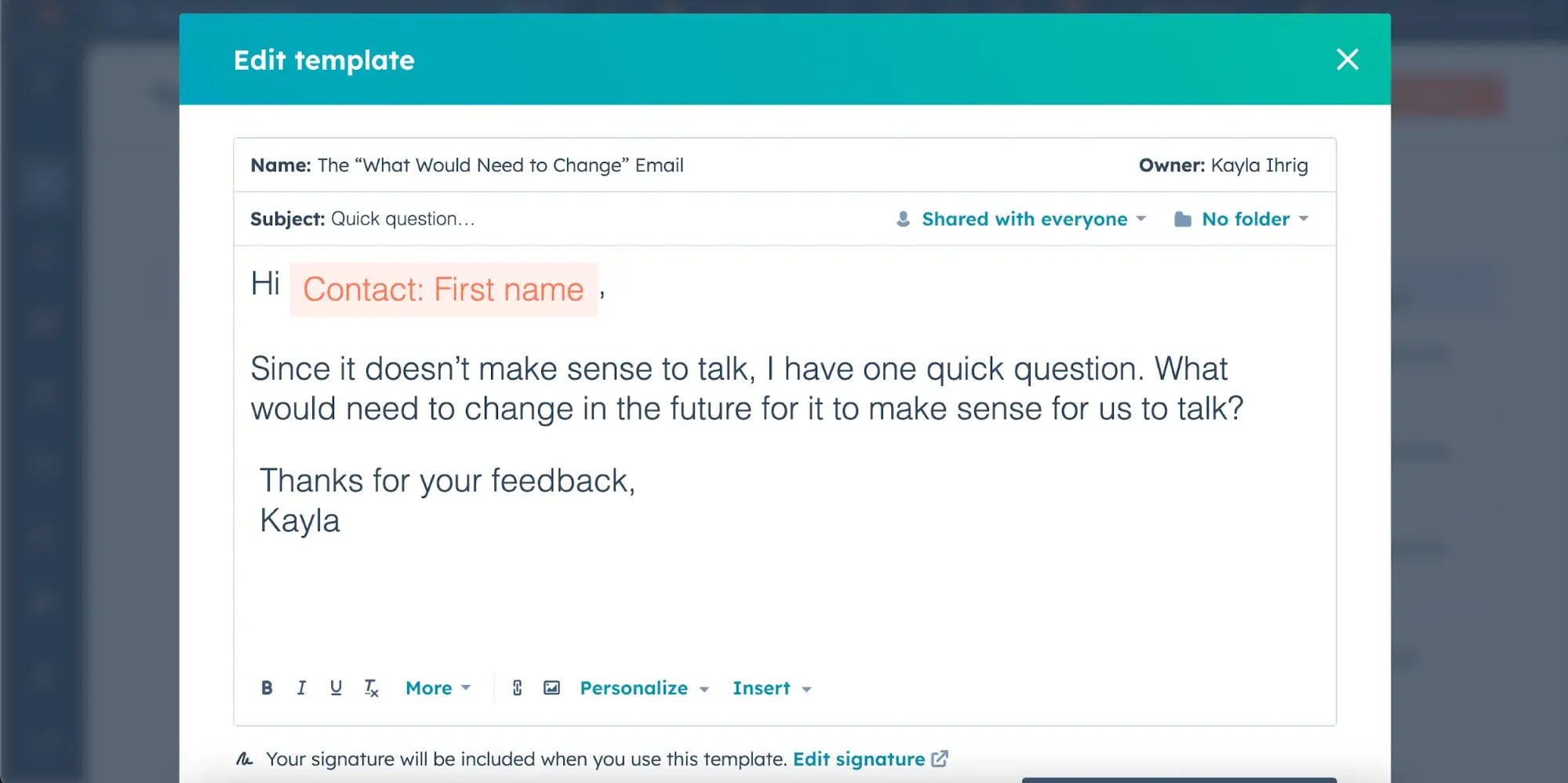
Why this follow-up email works:
- Emphasis on the relationship (“make sense for us to talk”) instead of the sale.
- Ellipsis in the subject line creates intrigue.
- Extremely brief, with a focus on the CTA.
2. Breakup Email
Here’s an example of an email following up with an inbound lead. You can see the template screenshot directly below, and my personalized version underneath (length: 91 words). I’m an SEO writer who works with businesses to build their blogs, so my email is written from that perspective.
Fun fact: This breakup email has a 33% reply rate. If only all breakups went that well!
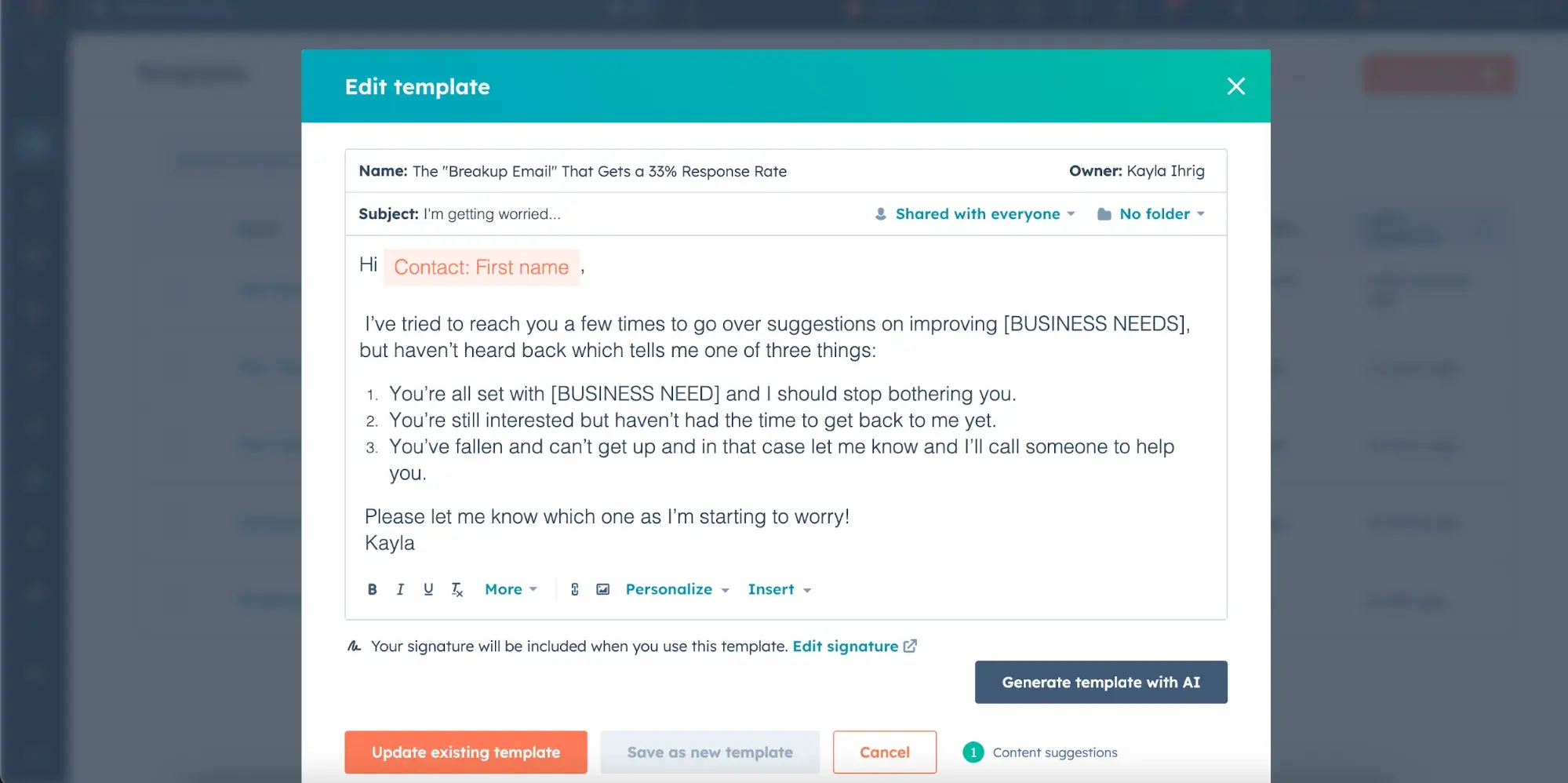
Hi [name],
I’ve tried to reach you a few times to go over suggestions on improving your website traffic, but haven’t heard back, which tells me one of three things:
- You’re all set with website traffic and your blog, and I should stop bothering you.
- You’re still interested but haven’t had the time to get back to me yet.
- You’ve fallen and can’t get up, and in that case, let me know and I’ll call someone to help you.
Please let me know which one. I’m starting to worry!
[Your Name]
Why this email works:
- You show that you’re thoughtful by acknowledging that you might be bothering them.
- Personality sells (you can use AI all you want, but people buy from people).
- It’s easy for the recipient to reply by choosing from your numbered list.
3. Inbound Lead From Content Follow-up Email
Let’s address the elephant on the screen: This email is longer than most. When the template is populated, this email runs at more than 100 words (mine is 106, to be exact). This is longer than most sales emails, but it brings a lot of value to the recipient.
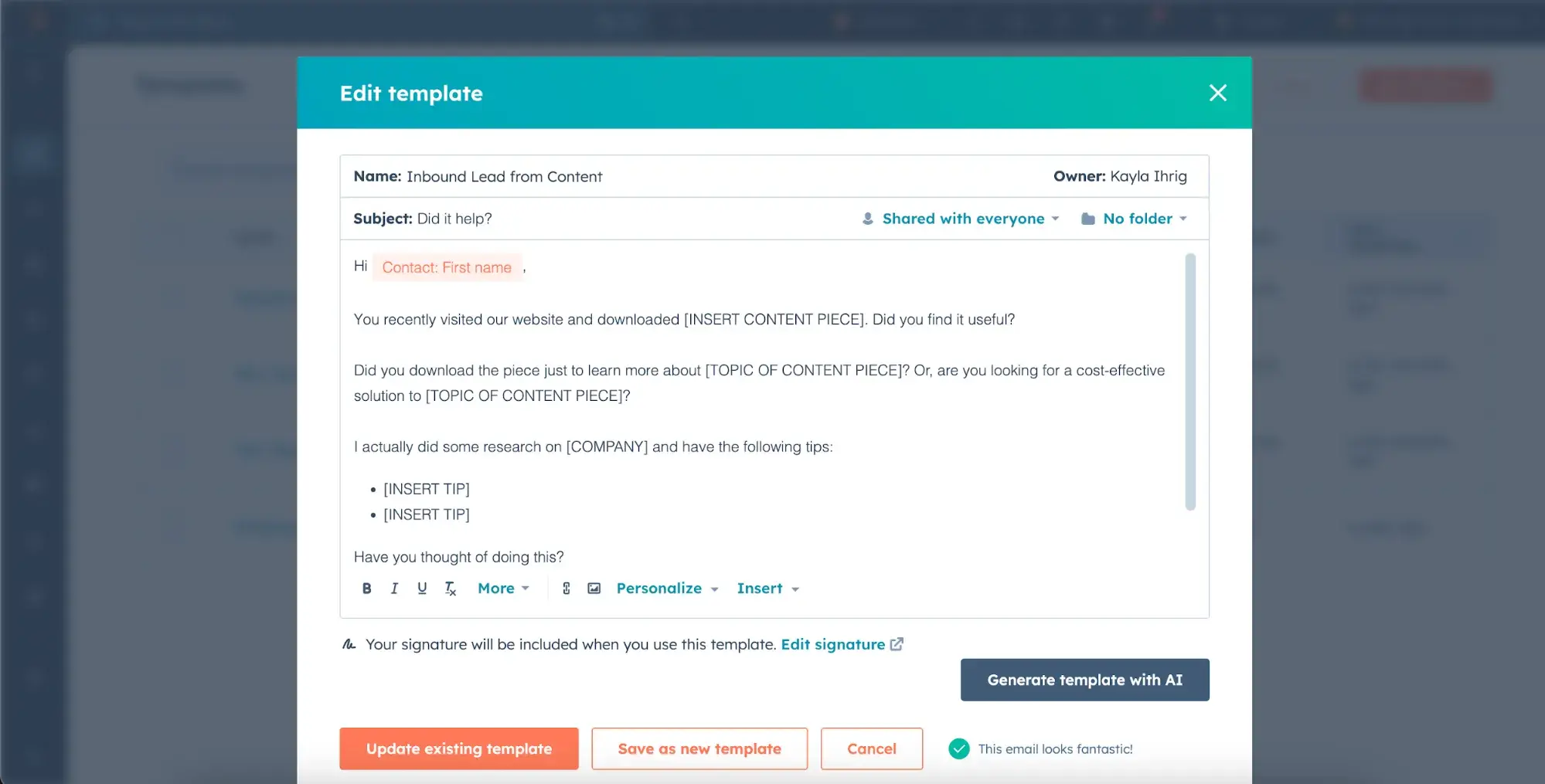
Hi [first name],
You recently visited my website and downloaded my blog SEO checklist. Did you find it useful?
Did you download the piece just to learn more about SEO in 2025? Or, are you looking for a cost-effective solution to the always-changing Google landscape?
I actually did some research on [COMPANY] and have the following tips:
- Your blog displays great expertise, but a quick audit of your most recent post shows that it has an optimization score of only 43 (out of 100).
- I think re-optimizing for the keyword [example] could help this stick the landing on Google.
Have you thought of doing this?
Best,
[Your Name]
Why this email works:
- The simple “Did it help?” subject line gets your prospect’s attention.
- Value-based content showing your expertise and helpfulness.
- Natural mention of pain points helps sell without feeling salesy.
- The emphasis on a “cost-effective solution” is a nice touch.
- Bullet points keep it organized and easy to skim.
Making Every Word Count
Remember: your prospects are drowning in emails just like you are. Stand out by being concise, relevant, and human. Test these templates, measure your results, and keep refining your approach. When every word serves a purpose, you‘ll find that shorter emails don’t just save time. They start conversations.
Don’t feel stuck with your emails. Use our templates to help you pick up momentum with your email marketing strategy.
Editor's note: This post was originally published in February 2016 and has been updated for comprehensiveness.



![Ghosted? How (and when) to send a follow-up email after no response [+ 18 examples]](https://53.fs1.hubspotusercontent-na1.net/hubfs/53/how-to-send-a-follow-up-email-after-no-response.jpg)


![23 Sales Email Templates With 60% or Higher Open Rates [+ Bonus Templates]](https://53.fs1.hubspotusercontent-na1.net/hubfs/53/sales-email-templates-2.jpg)

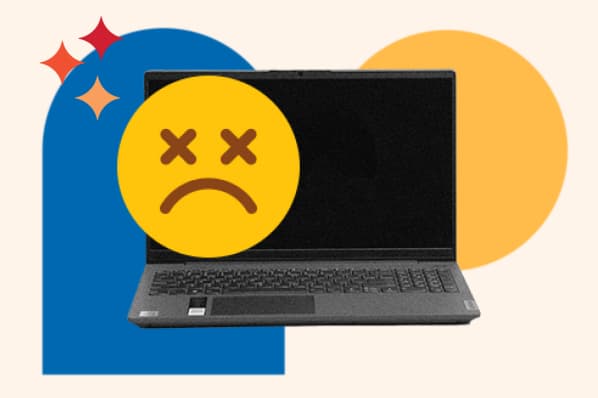
![How to Introduce Yourself in an Email in [Almost] Every Situation](https://53.fs1.hubspotusercontent-na1.net/hubfs/53/how-to-introduce-yourself-over-email-1.jpg)


